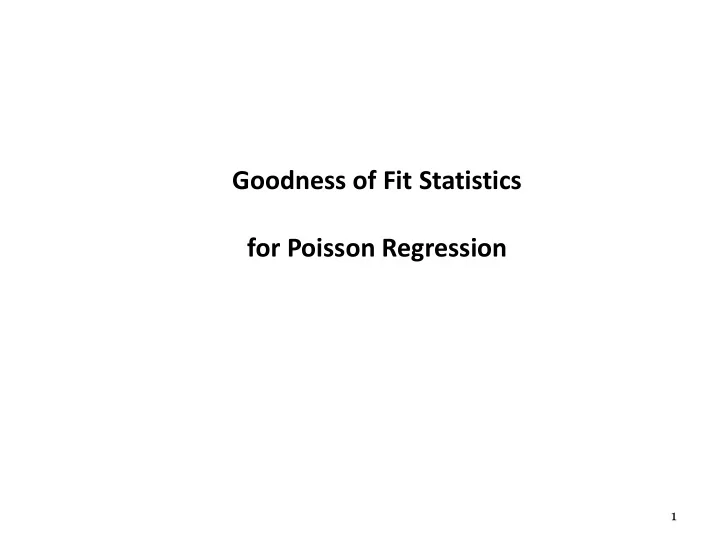

Goodness of Fit Statistics for Poisson Regression 1
Outline • Example 3: Recall of Stressful Events • Goodness of fit statistics – Pearson Chi-Square test – Log-Likelihood Ratio test 2
Example 3: Recall of Stressful Events • Let us explore another (simple) Poisson model example (no covariate to start with) 3
Example 3: Recall of Stressful Events • Participants of a randomised study where asked if they had experienced any stressful events in the last 18 months. If yes, in which month? • 147 stressful events reported in the 18 months prior to interview. 4
Example 3: Recall of Stressful Events • H 0 : Events uniformly distributed over time. H 0 : p 1 = p 2 = … = p 18 = 1/18 = 0.055 where p i = probability of event in month i. i.e. we would expect about 5.5% of all events per month 5
Example 3: Recall of Stressful Events Data month count % month count % 1 15 10.2 10 10 6.8 2 11 7.5 11 7 4.8 3 14 9.5 12 9 6.1 4 17 11.5 13 11 7.5 5 5 3.4 14 3 2.0 6 11 7.5 15 6 4.1 7 10 6.8 16 1 0.7 8 4 2.7 17 1 0.7 9 8 5.4 18 4 2.7 6
Evaluation of Poisson Model • Let us evaluate the model using Goodness of Fit Statistics • Pearson Chi-square test • Deviance or Log Likelihood Ratio test for Poisson regression • Both are goodness-of-fit test statistics which compare 2 models, where the larger model is the saturated model (which fits the data perfectly and explains all of the variability). 7
Pearson and Likelihood Ratio Test Statistics • In this last example, if H 0 is true the expected number of stressful events in month i (in any month) is (equiprobable model) E ( y ) = = 1 4 7 * (1 / 1 8 ) = 8 .1 7 m i i lo g ( ) = i = 1 , ,C m a i a • i.e. we have a model with one parameter 8
Observed and expected count Month Count Count Month Count Count Obs O i Exp E i Obs O i Exp E i 1 15 8.17 10 10 8.17 2 11 8.17 11 7 8.17 3 14 8.17 12 9 8.17 4 17 8.17 13 11 8.17 5 5 8.17 14 3 8.17 6 11 8.17 15 6 8.17 7 10 8.17 16 1 8.17 8 4 8.17 17 1 8.17 9 8 8.17 18 4 8.17 9
Pearson Chi-Squared Test Statistic • The Pearson chi-squared test statistic is the sum of the standardized residuals squared 2 O E 2 i i E cells i i 2 2 2 1 5 8 . 17 1 1 8 . 17 4 8 . 17 = 45.4 ... 8.17 8.17 8.17 10
Pearson Chi-Squared Test Statistic • If H 0 is true X 2 ~ χ 2 df where df = degrees of freedom = no. of cells – no. of model parameters = C - 1 • X 2 = 45.4 with 17 df (at 5% significance level the value from the chi-square table is 27.6) p-value < 0.001 reject H 0 . • Conclusion: There is strong evidence that the equiprobable model does not fit the data. 11
Log Likelihood Ratio Test Statistic for Poisson Regression • The Log Likelihood Ratio test statistic (also called Deviance of the Poisson Model) is O 2 i L 2 O log i E cells i i • This can be used as a measure of the fit of the model ( goodness of fit statistics ) 12
Log Likelihood Ratio Test • If H 0 is true L 2 ~ χ 2 df where df = degrees of freedom = no. of cells – no. of model parameters = C - 1 • L 2 = 50.8 with 17 df. p-value < 0.001 reject H 0 . • Conclusion: There is strong evidence that the equiprobable model does not fit the data. 13
Remarks • X 2 and L 2 are asymptotically equivalent. If they are not similar, this is an indication that the large sample approximation may not hold. • For fixed df, as n increases the distribution of X 2 usually converges to χ 2 df more quickly than L 2 . The chi-squared approximation is usually poor when expected cell frequencies are less than 5. 14
Recommend
More recommend